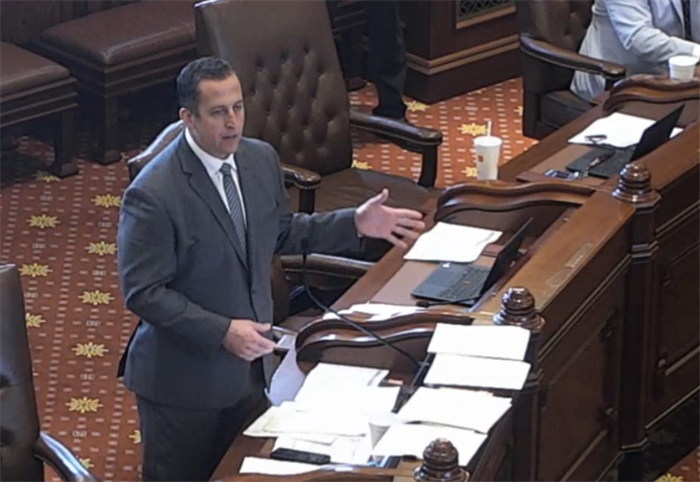Energy bill heads to Pritzker, who says he will sign it

Senate takes final legislative step on bill creating massive renewable, nuclear investment
By JERRY NOWICKI
Capitol News Illinois
jnowicki@capitolnewsillinois.com
SPRINGFIELD – The Illinois Senate put the final legislative stamp on an energy regulation overhaul bill Monday, sending it to Gov. JB Pritzker, who says he will sign it.
It’s the culmination of years of negotiation, and it marks a policy win on one of Pritzker’s biggest outstanding first-term campaign promises as the 2022 campaign heats up. The measure passed by a 37-17 vote, with Republicans Sue Rezin, of Morris, and John Curran, of Downers Grove, joining Democrats in support.
“After years of debate and discussion, science has prevailed, and we are charting a new future that works to mitigate the impacts of climate change here in Illinois,” Pritzker said in a statement after the bill’s Senate passage. “(Senate Bill) 2408 puts the state on a path toward 100 percent clean energy and invests in training a diverse workforce for the jobs of the future. Illinois will become the best state in the nation to manufacture and drive an electric vehicle, and equity will be prioritized in every new program created.”
The final proposal forces fossil fuel plants offline by 2045, spends billions of dollars to subsidize renewable and nuclear energy to prevent plant closures, incentivizes the adoption of electric vehicles, funds workforce training programs, and requires union labor on the installation of renewable infrastructure.
Advocates hailed it as a nation-leading climate bill, while downstate Republicans warned of its impact on consumer bills and energy grid reliability.
Senate President Don Harmon, D-Oak Park, said it sets the state on an “aggressive and progressive” path toward decarbonization and renewable energy adoption, while leaving pathways for future General Assemblies to reassess the state’s energy needs through follow-up legislation.
“Our goal all along was to enact reliable renewable and affordable energy policies that put Illinois in a position as the nation’s leader. That’s exactly what we’re doing here today,” Harmon said in closing floor debate. “Now, don’t get me wrong, there will be more votes, there will inevitably be changes. Innovations that we can’t even imagine today will happen tomorrow and we or some other future group of legislators will act accordingly.”
Investments, cost increases
The measure, Senate Bill 2408, aims to put Illinois on a path to a carbon-free energy future by 2050 by doubling the state’s ratepayer investment in renewable energy and further subsidizing the state’s nuclear fleet. It aims to increase the portion of the state’s energy produced by renewables from less than 8 percent to 40 percent by 2030 and 50 percent by 2040.
The main provision in the bill that would push the state toward those ambitious goals is a massive increase of more than $350 million annually to the pot of money funding renewable projects. It also provides that more than $300 million already collected for renewables will be spent for such projects instead of being refunded to ratepayers despite previous deadlines having passed.
The bill also provides $694 million in total over a five-year period to subsidize three nuclear plants owned by Exelon Corporation, preventing the closure of a plant in Byron that Exelon said it would take offline Monday in the absence of legislative action. It issued a statement after the bill’s passage saying it would begin the refueling process.
Other expenditures include a $180 million annual investment in equity-based and “just transition” programs aiming to diversify the renewable industry and to provide out-of-work fossil fuel employees with a pathway to renewable energy jobs.
The bill also provides subsidies to convert coal-fired plants to solar or energy storage facilities at about $47 million annually starting in 2024.
While the subsidies and investment programs are staggered in their implementation dates, the Citizens Utility Board estimates that it will cause an increase to ratepayer bills of about $3 to $4 a month over the next five years.
In terms of percentages, bill sponsor Sen. Michael Hastings, D-Frankfort, said residential electric bills would increase by about 3-4 percent, commercial bills by about 5-6 percent, and industrial bills by about 7-8 percent.
The senior advocacy group AARP estimated that number could be as high as $15 monthly for ratepayers, but advocates for the bill cite estimates in the CUB range.
Sen. Donald DeWitte, R-St. Charles, cited the AARP estimate and a Crain’s Chicago Business analysis which showed the increase could be between $7 and $8 monthly.
“The fact is, no one knows how much this piece of legislation is going to cost Illinois ratepayers,” he said. “What we do know is that it will be borne by all ratepayers in the state. I guess what we’re seeing and hearing today is that we’ll just have to watch our friends across the aisle pass this legislation, and then we’ll find out.”
The CUB analysis, meanwhile, said the investment in cheaper, renewable solar and wind energy could lead to lower costs for consumers over time.
Decarbonization, compromise
Large-scale renewable projects will be required to have project labor agreements to employ union labor, and non-residential labor projects, with the exception of small churches, will be required to pay a prevailing wage.
That stipulation was part of the final compromise that brought union and environmental groups together on the bill, along with decarbonization provisions for municipal power plants.
Specifically, two municipally-owned coal-fired power plants – a City, Water, Light and Power facility in Springfield and the Prairie State Energy Campus facility in Marissa – had caused a stalemate, as the plants and the lawmakers within their districts pushed back on the hard 2045 decarbonization date.
The final bill provides that the facilities must be carbon-free by 2045, and must reduce carbon emissions by 45 percent by 2035. If they can’t, they have three years to comply or shut down part of their generation capacities to come into compliance.
Other fossil fuel plants are required to go offline between 2030 and 2045, depending on the energy source and the level of carbon emissions.
With those plants going offline, nuclear energy, which provides more than half of the state’s energy mix, would become even more important.
But with only one nuclear plant in the MISO electric grid region which serves most of downstate Illinois south of Interstate 80, some Republicans warned of reliability issues.
Sens. Chapin Rose, R-Mahomet, and Terri Bryant, R-Murphysboro, said if the state’s fossil fuel plants are driven offline, Illinois will end up buying energy for a higher price from carbon-emitting power plants across state lines.
But Democrats say SB2408 specifically provides that the Illinois Environmental Protection Agency, Illinois Commerce Commission and Illinois Power Agency conduct a study at five-year intervals to determine whether renewables and nuclear are doing enough for grid sustainability.
If they’re not, Rep. Robyn Gabel, an Evanston Democrat who was one of the lead negotiators in the House, said the agencies could decide to leave some of the coal- or gas-fired plants online.
“The first wave of plants to close would be 2030, and so 2025 we’ll start the planning process in terms of grid reliability,” Hastings said in a news conference following the bill’s passage. “And through that we’ll determine, based on the planned closures, what’s the baseload generation going to be for the state of Illinois and we’ll make an assessment at that point whether or not we have to extend certain timelines, or put other measures in place.”
Hastings said inaction on an energy bill would have led to the closure of at least one nuclear power plant, driving up energy prices far beyond any increase included in the bill.
Republicans on the floor, including Sen. Dave Syverson, of Rockford, said they would have preferred a more targeted bill to prevent nuclear closures, but Democrats, including Harmon, said there wasn’t enough legislative support for such an action.
“For a Republican legislator to say vote ‘no’ to this legislation would cause, in essence, at least, one-third to two-thirds of our nuclear fleet to go offline,” Hastings said. “That would cause an import of energy.”
Equity, electric vehicles
The bill directs the Department of Commerce and Economic Opportunity to create the Clean Jobs Workforce Network program, which establishes 13 hubs in different communities across the state that rely on community-based organizations to provide job training and a career pipeline for equity-focused populations.
It also establishes a “Climate Bank” within the Illinois Finance Authority to help fund renewable projects, as well as a Jobs and Justice Fund, run by a nonprofit entity, aimed at ensuring “the benefits of the clean energy economy are equitably distributed.” Another program aims to train individuals recently released from incarceration for careers in the renewable energy field.
It also creates a Displaced Energy Worker Bill of Rights, requiring the Department of Commerce and Economic Opportunity to give advance notice of power plant or coal mine closures and to notify workers of available assistance programs.
The bill also sets a goal of putting 1 million electric vehicles on Illinois roads by 2030, aiming to do so through incentives, such as offering rebates on the installation of charging infrastructure in certain communities, provided prevailing wage is paid on the construction labor.
It offers a $4,000 rebate for electric vehicle purchases starting in 2022, but Hastings said that’s only in counties covered by the preexisting Alternative Fuels Act, meaning Cook and collar counties, because they pay into a fund from which the rebates will be paid.
While Republicans objected to rebates not being available downstate, Hastings said he’d work with them to identify a revenue stream to fund rebates in those areas.
Supporters said the bill also makes it more difficult for utility companies to raise consumer rates year after year by ending a formulaic rate increase process and instead taking into account “reliability, resiliency, peak load reduction, supplier diversity, affordability, request response time, customer service performance, minimizing greenhouse gas emissions,” and other factors when a company seeks a rate increase.
The citizen advocacy group PIRG, however, opposed the bill, saying it was still too easy for utility companies to guarantee profits under the new bill language.
The measure also prohibits utilities from charging late fees to low-income residential customers, and from charging a credit card fee on any consumer’s bill.
Editor’s note: This story has been updated to reflect that Sen. John Curran, R-Downers Grove, also voted in favor of the bill.
Capitol News Illinois is a nonprofit, nonpartisan news service covering state government and distributed to more than 400 newspapers statewide. It is funded primarily by the Illinois Press Foundation and the Robert R. McCormick Foundation.
Miss Clipping Out Stories to Save for Later?
Click the Purchase Story button below to order a print of this story. We will print it for you on matte photo paper to keep forever.

